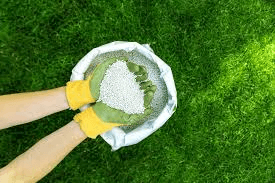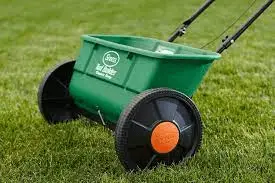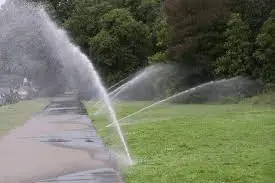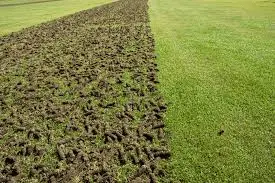Table of Contents

Your lawn needs the advantages of the Lawn Fertilizer Schedule to maintain that intensely lush, green appearance throughout the season. When you fertilize your property, you give it the ideal nutrients in its yearly growth cycle at the perfect moment. Like all other living things, grasses require food and water to exist. And they can thrive if given the proper nourishment. Fertilizer promotes the development of robust, full blades and deep roots. The best-looking grass will endure the challenges of weeds, heat, and drought.
This article will provide all the information about fertilizer, its uses, its essential nutrients, best application practices, and a standard schedule for applying fertilizer.
Fertilizer – Importance Of Its Uses
Lush, healthy grass can be grown and maintained with the help of fertilizer. Unfortunately, most homeowners avoid fertilizing their lawns because they are unsure of the right products or when and how to apply them. Furthermore, if lawn fertilizer is not administered correctly, it may cause more harm than good, further compounding the situation.

Fertilizer gives grass plants the nutrition they need to grow and thrive. It maintains the lawn’s aesthetic appeal, enhances the dark green hue, and enables it to withstand better seasonal turf challenges like heat, drought, and cold. Strong roots and a thick, lush lawn can help eliminate weeds by inhibiting their initial establishment.
Essential Nutrients of Lawn Fertilizers
Three nutrients that are essential fertilizers for the health of your lawn are nitrogen, phosphorus, and potassium, which are all found in fertilizer:
Nitrogen: This nutrient gives your lawn its distinctive shade of green and promotes lush, active growth.
Phosphorus: This nutrient promotes the growth of roots and aids in seed germination.
Potassium: This nutrient aids in grass resistance to harsh weather, illness, fungus, wear from foot traffic, and drought.
A Traditional Lawn Fertilizer Schedule
Look at this example Lawn Fertilizer Schedule with a blend of bluegrass, ryegrass, and fescue. It is recommended to fertilize lawns in four stages. The precise timing will vary depending on your grass type and where you reside. Ask experts in your area for advice suited to your particular circumstance. Read the directions thoroughly before using any commercial products to fertilize lawns. Your type of grass might not be a good fit for a specific product. In the best-case scenario, the following Lawn Fertilizer Schedule is required for your lawn:
- Mid- to late-April – 32-0-6 slow release (quick acting) spring fertilizer
- Early summer fertilizer, 25-0-5, 50% slow release, applied in early to mid-JUNE, six weeks later.
- Mid- to late-JULY late summer fertilizer, 25-0-5, 50% delayed release, applied six weeks later.
- Early fall fertilizer, 25-0-5 or 32-0-6 slow release, should be used in early to mid-SEPTEMBER (6 weeks later).
- NOVEMBER (6 weeks later) – slow-release winter fertilizer, 32-0-6
Best Practices For Applications
Always adhere to recommended fertilizer safety procedures when applying fertilizer. Mow your grass one to two days in advance for the best effects. Next, adjust your spreader according to the directions on the product label. For best results apply lawn fertilizers according to the following guidelines:
- If you want to use the conventional method, keep your applications at the recommended or lower label. Although the manufacturers of lawn chemicals would like that all customers use large amounts of fertilizer, the truth is that smaller amounts of fertilizer typically produce the same results and may even result in a healthier lawn.
- Select slow-release fertilizers that will keep feeding for several weeks. Apply them on the wet grass; the soil is moist but not suitable before a forecast calls for heavy rain. Before being absorbed by the earth, heavy storms can swiftly wash your fertilizer into storm drains.
- Apply fertilizers with a drop spreader rather than a broadcast spreader, which could scatter fertilizer pellets into sidewalks, driveways, or roadways. When it rains for the first time, fertilizer applied to hard surfaces will quickly wash into storm drains and water sources.

- To begin using drop spreaders, lay two strips across the ends of your lawn. Next, move back and forth while slightly overlapping each swath.
- When using broadcast spreaders, begin on the outside and work your way inside, slightly overlapping each step.
When you stop and turn, permanently close the hopper to avoid a fertilizer mound. To prevent iron stains and fertilizer runoff, sweep extra fertilizer off hard surfaces like sidewalks and driveways after application.
Recommended Fertilizer Ratio
Check Fertilizer Label
Check the fertilizer label before applying it for a three-letter or three-number code. This is consistent with the nutrients present inside.
N-P-K
The fertilizer’s percentages are represented by the three letters N-P-K, which stand for nitrogen, phosphorus, and potassium. Your grass requires all three: Potassium to control the chemistry of the turf grass, phosphorus to produce roots, and nitrogen for top growth and color.
- A 20-5-10 mixture, for instance, denotes a high-nitrogen fertilizer with 20% nitrogen, 5% phosphorous, and 5% potassium. Inert filler makes up the remaining portion, ensuring uniform distribution across your grass.
- Depending on the requirements of the grass and soil, fertilizers come in a variety of ratios. The following are distinct possibilities available at nurseries and home improvement stores: 5-10-5, 5-10-10, 6-6-18, 8-0-24, 10-10-10, and 20-5-10.
- Generally speaking, a 20-5-10 fertilizer combination is appropriate for giving New England’s grasses a nitrogen boost, helping feed your lawn in late spring. However, that is a potent amount of nitrogen to apply during the entire growing season and, if used excessively, will burn your plants. As the season continues, you’ll want to switch to less nitrogen-rich.
Irrigation
Watering your grass several days before and after fertilizer application will be more effective. Before applying the product, irrigation will keep the soil hydrated. It is crucial to water your lawn once more after fertilization since the water will activate the fertilizer in the ground and make it readily available to the turf roots. It won’t be as effective if you don’t water after fertilizing. See our lawn irrigation recommendations for optimal practices.

Sync Up With Aeration
Scheduled fertilization helps improve turf reaction and recovery if you intend to use a lawn aeration service. Additionally, it will promote deeper roots and result in thick, wholesome grass that inhibits the growth of weeds.

End Note
Using this lawn fertilization advice, you can maintain the performance, attractiveness, and health of your grass. We take pleasure in providing you with the best Lawn Fertilizer Schedule and professional advice, so you may have a lawn you’re happy to own.
Read this article for precise, relevant advice and deals to help you get the most out of your home lawn.
